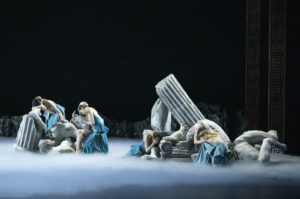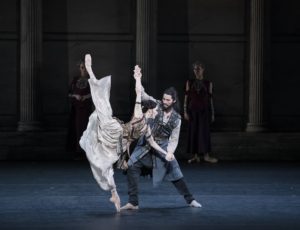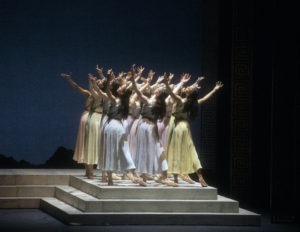American Ballet Theatre: Alexei Ratmansky / Of Love and Rage - Vancouver Ballet Society
- Home
- Reviews 2020 - 2023
- American Ballet Theatre: Alexei Ratmansky / Of Love and Rage

Of Love and Rage, a co-production with American Ballet Theatre and the National Ballet of Canada, had its world premiere run with ABT in early March at Segerstrom Hall in Costa Mesa, California. The two-act ballet by Alexei Ratmansky — artist-in-residence at ABT — runs approximately two hours and 20 minutes including intermission, with music by Aram Khachaturian (arranged by Philip Feeney) taken mostly from Gayane, the composer’s 1942 folk-styled Soviet ballet.
The lengthy synopsis for Of Love and Rage, for which Guillaume Gallienne served as dramaturg, spells out the choreographer’s plan to make a ballet scenario from the plot of Callirhoe, a first-century Greek work of fiction by Chariton of Aphrodisias, thought to be the first novel.

The costuming and scenery designed by Jean-Marc Puissant felt aptly Grecian, with simplified garments for the many characters, with 14 individually named ones plus 13 groups of secondary figures. Puissant’s changeable settings effectively establish the action in ancient Greece as well as in Babylon, marked at moments by the presence of a large sculpted head of the goddess Aphrodite.
The narrative thread, which proves convoluted, concerns the repeatedly thwarted love of Callirhoe and her swain Chaereas. The couple are married early in the chain of events, trying to remain together while several male characters succumb to the beauty of Callirhoe and stand in the way of their contentment. The ballet’s many incidents include one in which Chaereas’ misguided rage leads to Callirhoe’s seeming death and burial.
Callirhoe is described in the synopsis as “astonishingly beautiful,” just as she is repeatedly depicted in the novel, where her beauty is noted as being superior to that of Aphrodite. Any dancer cast in the role therefore faces a tall order. Happily for the first of his three ABT casts, Ratmansky chose a most winning Callirhoe candidate, the luminously lovely and beautifully accomplished Catherine Hurlin, a 24-year-old soloist.

Hurlin’s was the most remarkable performance of Callirhoe; in a third cast, Hee Seo made a strong impression even if she achieved something less in shimmer and impact. Principal dancer Christine Shevchenko, in the second cast, fared least well, lacking the fullness and finesse of physical expertise to render Ratmansky’s plastically rich and fluidly torsioned choreography with confidence and ease. The role’s use of ballet’s strict fifth position of the feet amid choreographic sequences brimming with demanding classical details too often looked laboured rather than intricate in Shevchenko’s performance.
Due to the injury of Calvin Royal III, meant to be Seo’s Chaereas, only two ABT men performed the role here. In the first cast, 21-year-old soloist Aran Bell supported Hurlin in Ratmansky’s acrobatic duets reliably, and danced through the ballet’s often athletically daring jumping and turning challenges with easy power, if without consistent finish. His dramatic demeanour lacked conviction and expression, making his Chaereas seem more petulant youth than poetic protagonist. Soloist Thomas Forster, opposite Shevchenko, revealed more depth of character and gestural finesse, though his physical strengths are less impressive.
The many details of the synopsis made it difficult to identify the different characters who surround the central couple. Stellar performances during this initial run, however, made some variously memorable. Among the men, riveting impact came from James Whiteside, who infused the character of Dionysius, a nobleman who marries Callirhoe when she believes Chaereas is dead, with firebrand force, as he worked with and against the other characters encountered in his efforts to keep Callirhoe’s hand. As Mithridates, a powerful regional governor, Cory Stearns created an individual whose dance and gestural language made his character into a notable foil for Dionysius, against whom he battles in the ballet’s climactic scene, set to Khachaturian’s widely known Sabre Dance, in which the two vie for Callirhoe’s affections.
As both Theron, a chief pirate, and an unnamed Egyptian General, Gabe Stone Shayer shone forcefully even if one might not be sure just which character he represented as he leapt, bounded and spun through his scenes. As the King of Babylon, intense Roman Zhurbin made much of a secondary figure through his artful mime and body language.
Of the featured women, who are less prominent among the cast of characters than the men, Katherine Williams made vivid impact as the Queen of Babylon, using her leggy physique and fleet technique to dart and posture through her scenes with chilling authority.

Some of Ratmansky’s most effective choreographic strokes are among his most delicate, often for groups, such as when tremolo musical moments key his 12-strong Chorus Ladies to pulsate delicately in place on pointe, which gives shimmering articulation to their finely gathered pastel dresses, as if they are so many fluted columns.
With the Khachaturian music more serviceable than memorable, the Sabre Dance arguably excepted, and with the oftentimes unclear and complicated plot, it was left to individual dancers to imbue the dramatic thrust intended for Of Love and Rage with impressive force. Fortunately, ABT already has a number of dancers to lead the charge.
— ROBERT GRESKOVIC
American Ballet Theatre performs Of Love and Rage at New York’s Metropolitan Opera House June 2-6, 2020. The work will have its Canadian premiere during the National Ballet’s 2021-2022 home season in Toronto.

